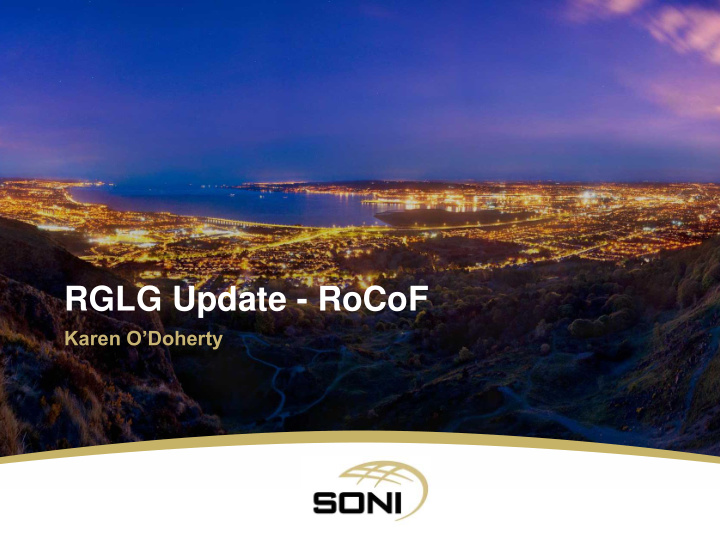



RGLG Update - RoCoF Karen O’Doherty
Background • April 2014 - Utility Regulator published approval in principal of SONI Grid Code modification to include minimum RoCoF requirement of 1Hz/s over 500ms (applied retrospectively) • Required SONI and NIE Networks to develop a programme to deliver changes to the G59 Loss of Mains protection settings
Timeline • March 2017 – TSO analysis highlights system security issues associated with 0.4Hz/s RoCoF setting on distribution connected generation – TSO implement an internal process to manage the risk to system security highlighted through analysis – SONI write to NIEN informing them of operational difficulties and encouraging a fast roll out of the new higher settings • April 2017 – Communication issued to all affected parties – Utility Regulator informed of operational difficulties being experienced and the mitigation measures being implemented
Timeline (2) • July 2017 – NIE Networks publish consultation re. generator interface protection settings. Proposal for LSG required to adopt new settings before 31 st December 2017 – SONI responded in favour of this aspect of this consultation • August 2017 – NIRIG write to NIE Networks (copy SONI) regarding this issue • September 2017 – SONI respond to NIRIG letter • October 2017 – SONI respond to specific generator queries
Timeline (3) • November 2017 – SONI begin to receive regular updated from NIEN when LSG RoCoF settings are changed – SONI update system models and dispatch down group as appropriate
Current Position (information correct as of 8/1/2018) • 44 of 59 sites are fully compliant with 1Hz/s over 500ms requirement (approx. 80% of MW capacity) • Non-compliant sites remain to be dispatched down due to system security concerns • Over Frequency settings are being updated at the same time as RoCoF
Conclusion • TSO took action to maintain system security and to comply with license conditions • Communications issued to impacted parties as soon as possible after risk was managed • Sites compliant with Distribution Code will no longer be dispatched down based on the 0.4Hz/s setting
Over Frequency Protection Settings Changes • Distribution connected large scale WFPS in Northern Ireland are also being requested to increase their over frequency protection setting from the old 50.5Hz setting • TSOs conducted analysis in 2015 whereby the over frequency protection settings of WFPS on the Island were increased above 50.5Hz and staggered to avoid a large simultaneous loss of generation • The staggered settings vary between 50.5Hz - 52Hz and generators were allocated a setting based on the required MW response and the location of the generation. The staggered nature of the over frequency protection settings covers a range of system conditions including various levels of wind, demand and interconnector flows
Over Frequency Protection Settings Changes (2) • Analysis has been completed on an all-island basis and generators will only have their settings increased from their previous setting • The operation of the over frequency protection is not expected to be a regular event and is seen as a system security measure. (Normal range 49.5Hz – 50.5Hz) • If operation of the power system is fundamentally different to these assumptions in the future, the TSO will review these settings through updated prudent analysis, recommend updated settings which takes account of the likelihood of tripping
Recommend
More recommend